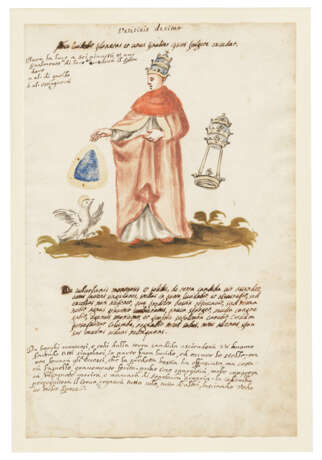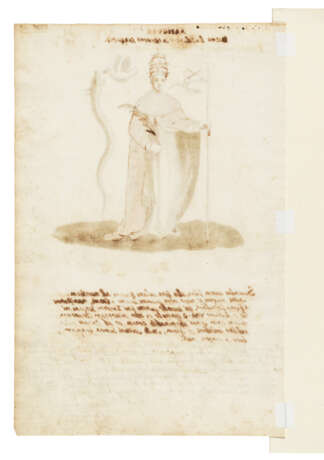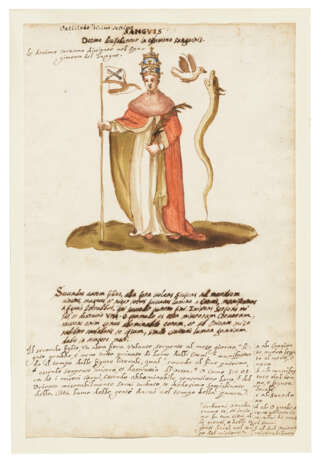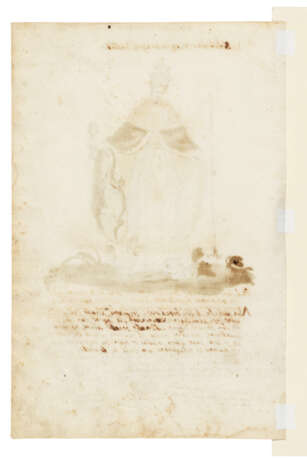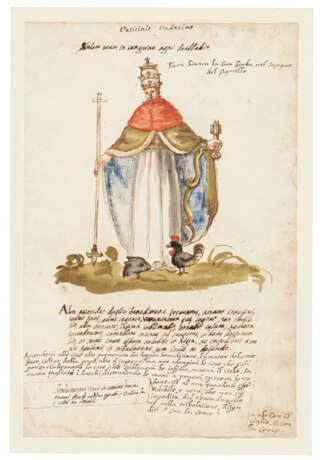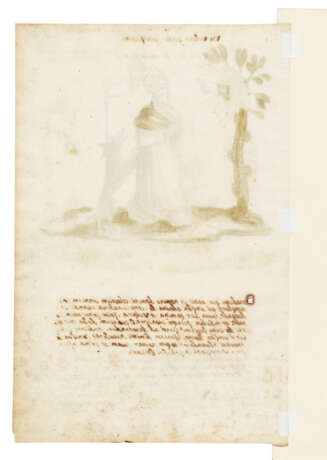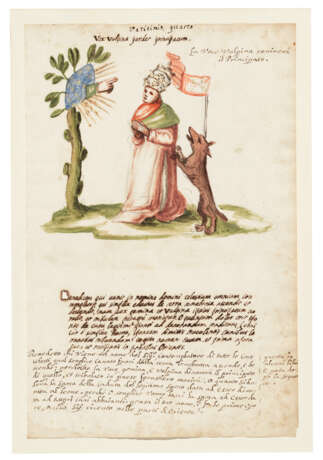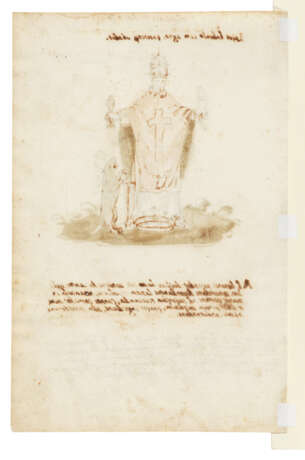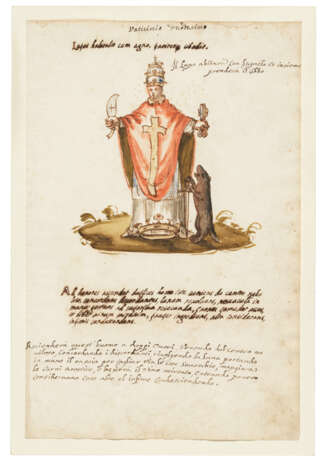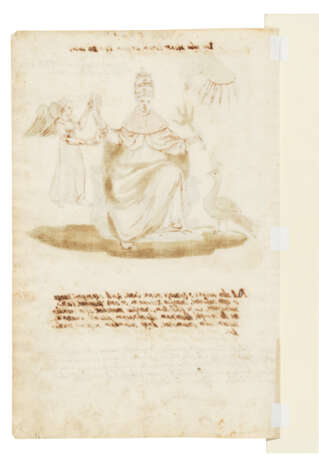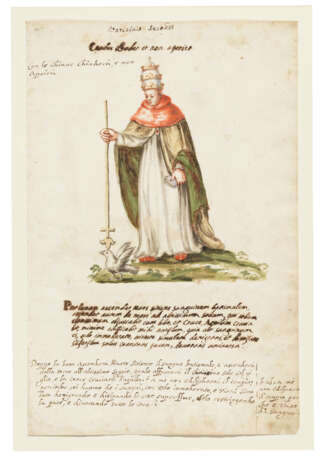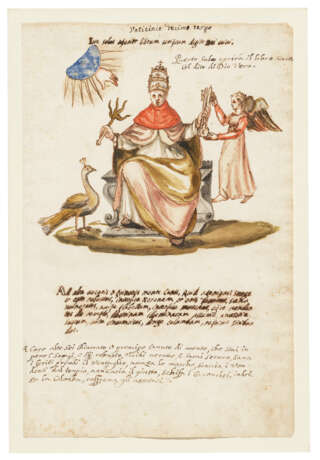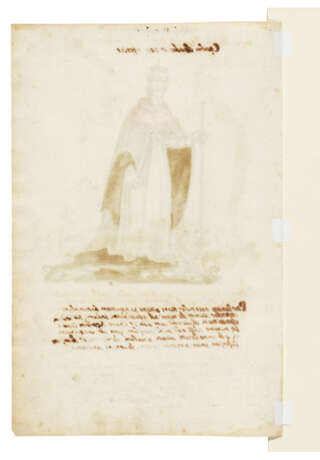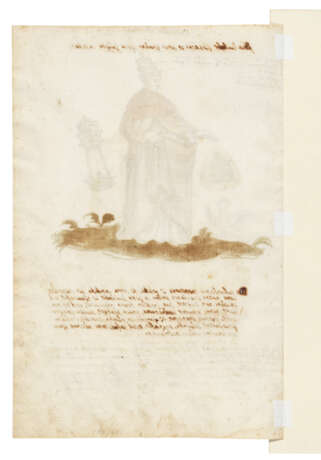ID 993150
Los 36 | Pseudo-Joachim de Fiore (late 13th century)
Schätzwert
£ 3 000 – 5 000
Vaticinia Pontificum, in Latin and Italian, 7 leaves from an illustrated manuscript on paper [Italy, 17th century]
Seven scenes from a 17th-century copy of the Vaticinia Pontificum, the 'best-selling' series of mystical prophecies concerning the papacy falsely attributed to the Calabrian mystic Joachim da Fiore (c.1130-1202).
415 x 275mm. 7 leaves (reverse blank), title and 5-8 lines in Latin, with corresponding translation in Italian added in a different but contemporary hand, the watermark a letter 'M' surmounted by a star in a shield, Briquet 8390, datable to Fabriano at the end of the 16th century (some marginal staining and foxing, some ink erosion to the Latin text). Each leaf mounted on card.
Content: This fragment contains prophecies 2, 4, 10, 11, 12, 13, 17.
The leaves are from one of the most intriguingly mystical and political of medieval texts: the series of some 30 prophecies concerning the papacy incorrectly ascribed to the famous Calabrian abbot and visionary, Joachim of Fiore (c.1135-1202). Derived perhaps from the Byzantine Oracles of Leo the Wise, the prophecies mix fantasy, allegory and the occult in a chronicle of the Church from Nicholas III (1277-1287) to the final pontiff (on this see R. Lerner, ‘On the origins of the earliest Latin pope prophecies, a reconsideration’, in Falschungen im Mittelalters, MGHS, 33V, 1988, pp.611-35; H. Grundman, ‘Die Papstprophetien des Mittelalters’, Archiv für Kulturgeschichte, XIX, 1928, pp. 77-138).
The earliest form, known as Genus nequam from its incipit, consisted of 15 scenes with accompanying texts and was circulating widely in Italy by the beginning of the 14th century (on this earliest form see M. Fleming, The late medieval Pope prophecies: the Genus nequam group, Medieval and Renaissance Text Studies, 204, 1999). This series was augmented in the 14th century by a group known as the Ascende Calve (again, from their incipits), and most recently assigned to an Italian Ghibelline cultural milieu, perhaps that of the Visconti rulers of Milan, who were involved in a series of violent disagreements with the papacy at this time (see H. Millet and D. Rigaux, ‘Ascende Calve: Quand l’historien joue au prophète’, Studi Medievali, XXXIII, 1992, pp.707-8).
The collected prophecies, rebranded Vaticinia Pontificum, quickly achieved the status of ‘best-seller’: they appear in a large number of manuscripts from the later 14th and 15th centuries, all the way through to the 17th. The text was first printed in Venice in c.1501-10, and ran to 10 further editions during the 16th century. In spite of its importance in the history of medieval spiritual life, manuscripts of the Vaticinia are not common on the market.
The subjects of the illustrations are as follows:
f.1 'Clavibus claudet et non aperiet’: a Pope with an upturned cross in his right hand prodding an eagle, in his left hand a book; title in Italian identifying it as the 2nd prophecy. The Pope is usually identified as Martin IV (1281-1285), the bird perhaps symbolises Michael Paleologus, the Byzantine Emperor, whom Martin excommunicated.
f.2 ‘Vox vulpina perdet principatum’: a Pope kneeling in prayer before a tree from which issues a blessing hand, the standard of St Peter behind him and a fox attacking him from behind; the title in Italian identifying it as the 4th prophecy. The Pope is usually identified with Celestine V (1294), and the fox is Cardinal Benedetto Gaetani, who forced his abdication.
f.3 'Sex lucidabit planetas et unus finaliter ipsius fulgorem excedet’: a Pope, with a triple crown beside him, blessing a dove underneath a group of stars; the title in Italian identifying it as the 10th prophecy. The Pope is generally identified as Benedict XII (1334-1342). According to Scaliger, the six stars are the six cardinals created by this Pope and the dove is the Emperor Louis the Bavarian, with whom Benedict attempted a reconciliation. The tiara floating in the air to the Pope’s left represent the Pope’s sending of a legate to Rome for the nomination of senators, in place of having this officer sent by the Emperor.
f.4 'Stolam suam in sanguine Agni dealbabit’: a Pope with a cross in his right hand, in his left the keys of St.Peter, a snake grasping his wrist, with a cockerel and the head of a dog at his feet; the title in Italian identifying it as the 11th prophecy. The Pope is usually identified as Clement VI (1342-52). According to Scaliger, the dog’s head is Andrew, son of Charles of Anjou, king of Hungary, of whose murder the Pope cleared Andrew’s wife, Queen Joanna. The serpent is the emblem of the Visconti, the cross is the alliance of Philip VI of France and Edward III of England for Italy’s protection.
f.5 'Lupus habitabit cum agno, pariterque cibabit': a Pope standing within a crown, holding the keys of St Peter and a blade, a wolf to the right supporting himself on a sword; the title identifying it as the 12th prophecy. The Pope is usually identified as Innocent VI (1352-1362). According to Scaliger, the keys and the blade represent the Pope’s desire to purify the Church, the wolf the uprising in Rome which Cola di Rienzi was to have suppressed. The crown is an allusion to the coronation of Charles IV in Rome, or possibly to the dignity of the tribunes, which were abolished by the Pope.
f.6 ‘Iste solus clare aperiet librum scriptum digito Dei vivi’: a seated Pope holding a scourge and the keys of St Peter; a peacock at his feet and a blessing hand emerging from a group of stars on the left; an angel flying in from the right to support the keys; title in Italian identifying it as the 13th prophecy. The Pope is generally identified as Urban V (1362-1370). According to Scaliger, the scourge represents the attack of Cardinal Agidius Carriglius against Barberino Visconti. The angel typifies God’s aid with which the Pope briefly returned the Papal seat to Rome in 1367. The peacock symbolises the Pope’s love of justice and piety.
f.7 'Decime dissipabuntur in effusione sanguinis’: a Pope holding the standard of St Peter and a palm frond, on the right a flying dove and a leaping snake; title in Italian identifying it as the 17th prophecy. The Pope is usually identified as Innocent VII (1404-1406). The serpent is possibly an allusion to the Great Schism which arose at this time.
Special notice
This lot has been imported from outside of the UK for sale and placed under the Temporary Admission regime. Import VAT is payable at 5% on the hammer price. VAT at 20% will be added to the buyer’s premium but will not be shown separately on our invoice.
| Künstler: | Joachim de Fiore (1135 - 1202) |
|---|---|
| Herkunftsort: | Italien, Europa |
| Kategorie des Auktionshauses: | Handschriften des Mittelalters und der Renaissance |
| Künstler: | Joachim de Fiore (1135 - 1202) |
|---|---|
| Herkunftsort: | Italien, Europa |
| Kategorie des Auktionshauses: | Handschriften des Mittelalters und der Renaissance |
| Adresse der Versteigerung |
CHRISTIE'S 8 King Street, St. James's SW1Y 6QT London Vereinigtes Königreich | |
|---|---|---|
| Vorschau |
| |
| Telefon | +44 (0)20 7839 9060 | |
| Aufgeld | see on Website | |
| Nutzungsbedingungen | Nutzungsbedingungen |
